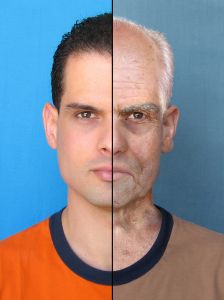Is a 1000 year old human a possibility?
 Sun, June 1, 2008 at 2:29 PM
Sun, June 1, 2008 at 2:29 PM  Can Humans Live to 1,000? Some Experts Claim We Can.
Can Humans Live to 1,000? Some Experts Claim We Can.
Cambridge University geneticist Aubrey de Grey has famously stated, “The first person to live to be 1,000 years old is certainly alive today …whether they realize it or not, barring accidents and suicide, most people now 40 years or younger can expect to live for centuries.”
Perhaps de Gray is way too optimistic, but plenty of others have joined the search for a virtual fountain of youth. In fact, a growing number of scientists, doctors, geneticists and nanotech experts—many with impeccable academic credentials—are insisting that there is no hard reason why ageing can’t be dramatically slowed or prevented altogether. Not only is it theoretically possible, they argue, but a scientifically achievable goal that can and should be reached in time to benefit those alive today.
“I am working on immortality,” says Michael Rose, a professor of evolutionary biology at the University of California, Irvine, who has achieved breakthrough results extending the lives of fruit flies. “Twenty years ago the idea of postponing aging, let alone reversing it, was weird and off-the-wall. Today there are good reasons for thinking it is fundamentally possible.”
Even the US government finds the field sufficiently promising to fund some of the research. Federal funding for “the biology of ageing”, excluding work on ageing-specific diseases like heart failure and cancer – has been running at about $2.4 billion a year, according to the National Institute of Ageing, part of the National Institutes of Health.
So far, the most intriguing results have been spawned by the genetics labs of bigger universities, where anti-ageing scientists have found ways to extend live spans of a range of organisms—including mammals. But genetic research is not the only field that may hold the key to eternity.
“There are many, many different components of ageing and we are chipping away at all of them,” said Robert Freitas at the Institute for Molecular Manufacturing, a non-profit, nanotech group in Palo Alto, California. “It will take time and, if you put it in terms of the big developments of modern technology, say the telephone, we are still about 10 years off from Alexander Graham Bell shouting to his assistant through that first device. Still, in the near future, say the next two to four decades, the disease of ageing will be cured.”
But not everyone thinks ageing can or should be cured. Some say that humans weren’t meant to live forever, regardless of whether or not we actually can.
“I just don’t think [immortality] is possible,” says Sherwin Nuland, a professor of surgery at the Yale School of Medicine. “Aubrey and the others who talk of greatly extending lifespan are oversimplifying the science and just don’t understand the magnitude of the task. His plan will not succeed. Were it to do so, it would undermine what it means to be human.”
It’s interesting that Nuland first says he doesn’t think it will work but then adds that if it does, it will undermine humanity. So, which is it? Is it impossible, or are the skeptics just hoping it is?
After all, we already have overpopulation, global warming, limited resources and other issues to deal with, so why compound the problem by adding immortality into the mix.
But anti-ageing enthusiasts argue that as our perspectives change and science and technology advance exponentially, new solutions will emerge. Space colonization, for example, along with dramatically improved resource management, could resolve the concerns associated with long life. They reason that if the Universe goes on seemingly forever—much of it presumably unused—why not populate it?
However, anti-ageing crusaders are coming up against an increasingly influential alliance of bioconservatives who want to restrict research seeking to “unnaturally” prolong life. Some of these individuals were influential in persuading President Bush in 2001 to restrict federal funding for embryonic stem cell research. They oppose the idea of life extension and anti-ageing research on ethical, moral and ecological grounds.
Leon Kass, the former head of Bush’s Council on Bioethics, insists that “the finitude of human life is a blessing for every human individual”. Bioethicist Daniel Callahan of the Garrison, New York-based Hastings Centre, agrees: “There is no known social good coming from the conquest of death.”
Maybe they’re right, but then why do we as humans strive so hard to prolong our lives in the first place? Maybe growing old, getting sick and dying is just a natural, inevitable part of the circle of life, and we may as well accept it.
“But it’s not inevitable, that’s the point,” de Grey says. “At the moment, we’re stuck with this awful fatalism that we’re all going to get old and sick and die painful deaths. There are a 100,000 people dying each day from age-related diseases. We can stop this carnage. It’s simply a matter of deciding that’s what we should be doing.”
One wonders what Methuselah would say about all this.
 96 Comments | | posted in
96 Comments | | posted in  The Human Condition
The Human Condition 



